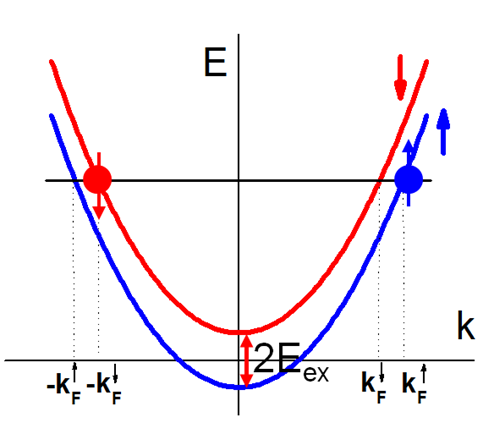Research
Superconductor/Ferromagnet Hybrid Systems
 When a superconductor (S) is put in contact with a normal metal (N), the normal metal
takes on some superconducting-like properties near the S/N interface. This "proximity
effect" can extend several hundreds of nanometers into the N layer at very low temperatures.
When a superconductor is put in contact with a ferromagnet (F), the situation is more
interesting, as illustrated in the cartoon to the right. The ferromagnet F is represented
by a spin-up band and a spin-down band, which are separated by the twice the exchange
energy, Eex. When the two electrons from a Cooper pair enter F, they must enter different spin
bands. Hence the pair acquires a finite momentum â„Q, where Q = kF↑ - kF↓ = 2Eex/ â„vF. Alternatively, one can say that the pair correlation function oscillates with wavevector
Q. That oscillation decays algebraically in ballistic systems, or exponentially in
diffusive systems. The oscillation period is 2πξF = 2π/Q = hvF/2Eex. Large values of Eex (of order one electron-Volt) in strong ferromagnets lead to very short values of
the oscillation period - about 1 nm in Ni, Fe, or Co.
When a superconductor (S) is put in contact with a normal metal (N), the normal metal
takes on some superconducting-like properties near the S/N interface. This "proximity
effect" can extend several hundreds of nanometers into the N layer at very low temperatures.
When a superconductor is put in contact with a ferromagnet (F), the situation is more
interesting, as illustrated in the cartoon to the right. The ferromagnet F is represented
by a spin-up band and a spin-down band, which are separated by the twice the exchange
energy, Eex. When the two electrons from a Cooper pair enter F, they must enter different spin
bands. Hence the pair acquires a finite momentum â„Q, where Q = kF↑ - kF↓ = 2Eex/ â„vF. Alternatively, one can say that the pair correlation function oscillates with wavevector
Q. That oscillation decays algebraically in ballistic systems, or exponentially in
diffusive systems. The oscillation period is 2πξF = 2π/Q = hvF/2Eex. Large values of Eex (of order one electron-Volt) in strong ferromagnets lead to very short values of
the oscillation period - about 1 nm in Ni, Fe, or Co.
Applications to Cryogenic Memory
Today's supercomputers are large and power hungry. There is an increasing need for data centers and large computing facilities that conventional CMOS technology is not equipped to handle. Estimates suggest a superconducting computer would be orders of magnitude more energy efficient than current semiconductor-based supercomputers. In order to realize this possibility, there is a need for superconducting cryogenic memory. Our collaborators at Northrop Grumman have developed a theoretical memory cell to meet this need that utilizes phase-controllable Josephson junctions like the one we made above. They continue to work on the read/write mechanism for the memory cell as well as the superconducting logic circuits for the supercomputer. Once our switchable junctions are fully optimized, we plan to combine them with Northrop's cell to create a fully functional Random Access Memory.
Selected Publications
"Amplitude control of spin-triplet supercurrent in S/F/S Josephson junctions," W. Martinez, W.P. Pratt, Jr., and N.O. Birge, Phys. Rev. Lett. 116, 077001 (2016).
"Controllable 0-π Josephson junctions containing a ferromagnetic spin valve," E. C. Gingrich, Bethany M. Niedzielski, Joseph A. Glick, Yixing Wang, D. L. Miller, Reza Loloee, W. P. Pratt Jr, & Norman O. Birge. Nature Physics 12, 564 (2016).
"S/F/S Josephson Junctions with Single Domain Ferromagnets for Memory Applications," B.M. Niedzielski, E.C. Gingrich, R. Loloee, W.P. Pratt, Jr., and N.O. Birge, Supercond. Sci. Technol. 28, 085012 (2015).
"Spin-triplet supercurrent in Co/Ni multilayer Josephson junctions with perpendicular anisotropy," E.C. Gingrich, P. Quarterman, Y. Wang, R. Loloee, W.P. Pratt, Jr., and N.O. Birge, Phys. Rev. B 86, 224506 (2012).
"Optimization of spin-triplet supercurrent in ferromagnetic Josephson junctions," C. Klose, T.S. Khaire, Yixing Wang, W.P. Pratt, Jr., N.O. Birge, B.J. McMorran, T.P. Ginley, J.A. Borchers, B.J. Kirby, B.B. Maranville, and J. Unguris, Phys. Rev. Lett. 108, 127002 (2012).
"Proximity-induced density-of-states oscillation in a superconductor/strong ferromagnet system," K. Boden, W.P. Pratt, Jr., and N.O. Birge, Phys. Rev. B 84, 020510(R) (2011).
"Spin-triplet supercurrent in Co-based Josephson junctions," M.A. Khasawneh, T.S. Khaire, C. Klose, W.P. Pratt, Jr., and N.O. Birge, Supercond. Sci. Technol. 24, 024005 (2011).
"Observation of spin-triplet superconductivity in Co-based Josephson junctions," T.S. Khaire, M.A. Khasawneh, W.P. Pratt, Jr., and N.O. Birge, Phys. Rev. Lett. 104, 137002 (2010).

